Drosanthemum aasvoelbergense
Drosanthemum aasvoelbergense Van Jaarsv.
Family: Aizoaceae
Common names: Aasvoelberg mesemb (Eng.); Aasvoelberg-douvygie (Afr.)
Introduction
The Aasvoelberg mesemb is a rare endemic of the upper south-facing cliffs of the Aasvoelberg, north west of Willowmore in the Eastern Cape. The sprawling to mat-forming succulent growth makes it a great ground cover, especially for cool waterwise alpine gardens. It is covered in pink to light pink flowers during late spring and attracts honey-bees. Also a good subject for hanging baskets.
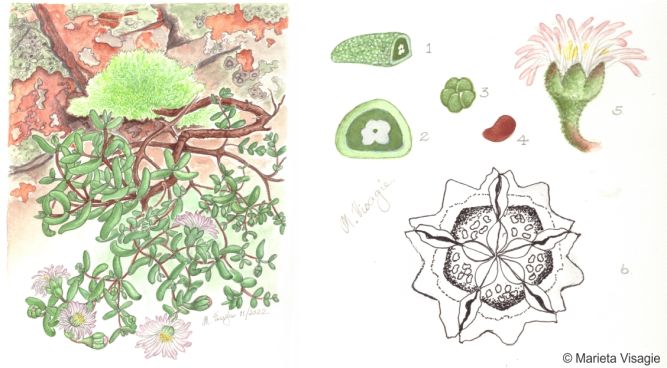
Fig. 1. Illustration of Drosanthemum aasvoelbergense, by Marieta Visagie, showing a plant in habitat on a sheer cliff growing among moss and lichens, a cross-section of a leaf (1 & 2), calyx lobes of a young flower bud (3), a seed (4) a mature flower (5) and an open fruiting capsule (6).
Description
Description
Plants much-branched, long-lived, woody, densely divaricately and fastigiate branched, succulent leaved shrublets, with age forming an intertwined network of stems, becoming pendent from the cliff face, 200–1000 mm long and up to 400 mm in diameter. The main branch can grow up to 25 mm in diameter at the base. The the older roots up to 15 mm diameter and woody. The young branchlets 0.5 mm diameter, terete, at first green and covered in rounded papillae, soon becoming woody, brownish and smooth. The main branch is 5-25 mm in diameter, terete, slightly thickened and knobby at the nodes. The growth is irregular and rich branching in all directions, forming a tangled network. The bark is longitudinally fissured in older specimens and the internodes 2-15 mm apart.
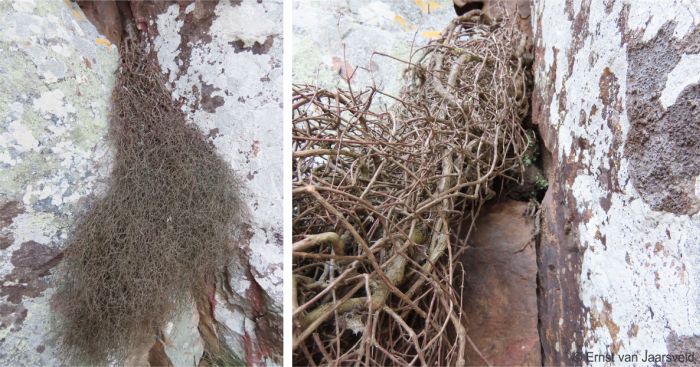
Fig. 2. An old senescent, at least 25 year old, cliff-hanger specimen of Drosanthemum aasvoelbergense, about 1 m long, growing on the upper shady south-facing cliff-face of Aasvoelberg and a close-up of the base of the plant showing the intertwined branches.
The leaves are green, ascending spreading, in opposite pairs, succulent 10–20 x 3–4 mm, green and the lower portion somewhat boat-shaped to slightly three-angled. The upper surface flat to convex and lower surface roughly keeled, the surface covered with rounded translucent moisture filled papillae, the tip blunt. Flowers solitary, at branch ends 18–25 mm in diameter; pedicels 5–10 mm long. The receptacle is funnel-shaped, 5 mm deep, 8–10 mm in diameter with 2 outer triangular-lanceolate sepals 4 × 3 mm, and 3 smaller inner triangular sepals 3 × 2 mm. The petals are light pink, linear spear-shaped, 10–15 × 1.3–1.5 mm, spreading and becoming recurved. Filamentous staminodes are absent. The stamens are numerous, at first in a central tall cone, the filaments 5 mm long, white and at first overtopping the stigmas, the anthers cream coloured, 0.7 mm, pollen same colour as anthers. The stigmas 5, pointed, and when mature becoming 5–8 mm long, whitish, densely papillate. The nectar glands dark green and in a marginal ring. The capsule is funnel shaped, 10 mm in diameter and 5 mm deep, bearing crested rims about 1.5 mm high. The valve wings broad, translucent (open capsule) and the expanding keels distant but parallel, whitish sometimes wavy. The covering membranes or loculi roofs weakly developed and only partially covering the seeds. The seeds are ochre coloured, pear shaped, slightly flattened, minutely tuberculate 0.7–0.8 x 0.5 mm long. Flowering time is in late spring and early summer (November to December). Seed dispersed in summer and autumn when the capsules mature.
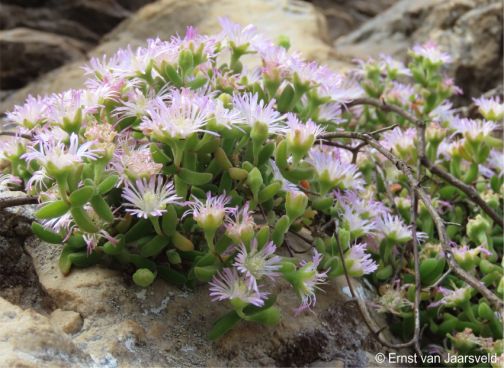
Fig. 3. Drosanthemum aasvoelbergense in full flower on the cool upper south-facing cliff of the Aasvoelberg.
Conservation Status
Status
Drosanthemum aasvoelbergense is a newly described species that has not yet been formally assessed by the Red List of South African Plants. However, it is not threatened, due to its inaccessible habitat, but, because of its restricted distribution and being known to occur only on the upper south-facing cliffs of a single mountain, it can be regarded as Rare.
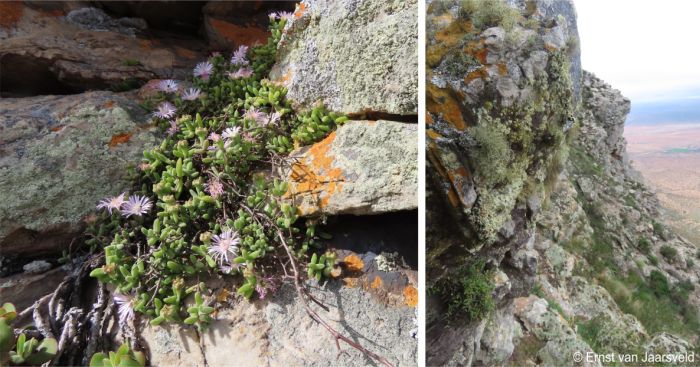
Fig. 4 Drosanthemum aasvoelbergense cascading down the upper rock face at Aasvoelberg and the lichen covered cliffs of Aasvoelberg, looking east, with a plant of Drosanthemum aasvoelbergense in the lower left corner.
Distribution and habitat
Distribution description
Drosanthemum aasvoelbergense is only known from the upper south-facing cliffs of Aasvoelberg in the Eastern Cape, north west of Willowmore. The plants are locally abundant in this protected habitat. The Aasvoelberg forms part of the northern outlier of the Cape Fold Mountains and the eastern end of the Boesmanspoortberg Range. The rocks are mineral-poor, quarzitic sandstone of the Witteberg series (Cape Supergroup). The Aasvoelberg vegetation on the upper slopes consists of Grootrivier Quartzite Fynbos of the Fynbos Biome (Mucina et al. 2006). Although Fynbos at the top, it is surrounded by Nama Karoo and Thicket vegetation remnants on its lower slopes. The sheer upper south-facing cliff habitat is in almost constant shade from autumn to spring.
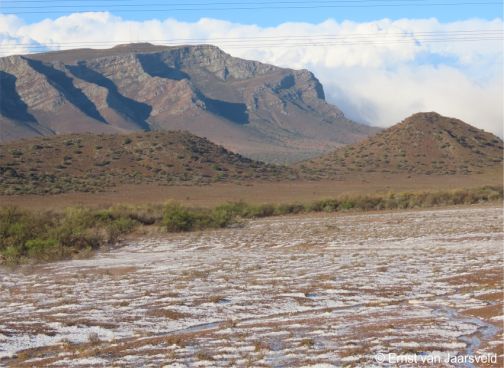
Fig. 5. Aasvoelberg, near Willowmore in the Eastern Cape, represents the eastern end of the Boesmanspoortberge mountain range, here photographed after a hail storm. Drosanthemum aasvoelbergense grows on the upper south-east facing cliffs.
The vegetation here is a mixture of Thicket, Fynbos and Nama Karoo. Although fire is commonly encountered in Fynbos, the cliff habitat is sparsely vegetated, dominated by succulents and relatively free of fire. Drosanthemum aasvoelbergense is long-lived, unlike many species of Drosanthemum which are short lived. Associated cliff dwelling succulents and bulbous plants in its cliff-face habitat include: Adromischus subdistichus, Cotyledon orbiculata var. oblonga, Cotyledon woodii, Crassula atropurpurea, Crassula biplanata, Crassula nemorosa, Crassula nudicaulis, Crassula pellucida subsp. marginalis, Crassula perfoliata var. minor, Crassula perforata, Crassula pubescens subsp. rattrayi, Crassula rupestris subsp. rupestris, Crassula saxifraga, Crassula socialis, Carpobrotus deliciosus, Delosperma esterhuyseniae, Esterhuysenia alpina, Lampranthus affinis, Machairophyllum albidum, Haworthia monticola, Crassothonna cacalioides, Curio citriformis, Curio crassulifolius, Drimia minor, and a dwarf white-flowering species of Ornithogalum (Hyacinthaceae) and Bulbine rupicola.
Temperatures in this alpine climate are relatively low, especially during winter, with occasional snow. The average daily maximum temperature is about 26°C and average daily minimum about 8–10°C. Rainfall occurs in winter and summer, about 300 mm per annum, and can occur at any time of the year. During winter and spring, rainfall is due to cyclonic cold fronts from the south; in summer and autumn, rain occurs as a result of convectional precipitation.
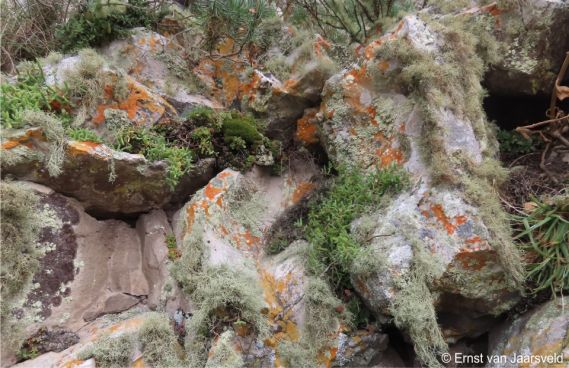
Fig. 6. The mountain top habitat of Drosanthemum aasvoelbergense is sometimes covered in fog or cloud, resulting in moist air, which supports the growth of the numerous species of lichen that share this habitat. Note also the associated Crassula socialis, Bulbine rupicola and Crassula atropupurea.
Derivation of name and historical aspects
History
The epithet aasvoelbergense, meaning ‘from Aasvoelberg’, refers to the name of the mountain (berg in Afrikaans) on which this plant grows. Aasvoel is Afrikaans for vulture, and in this case pertains to the Cape Vulture (Gyps coprotheres), that used to roost on the cliffs of the Aasvoelberg.
Drosanthemum aasvoelbergense was named by the author in the American Cactus and Succulent Journal in 2023 from plants collected on the Aasvoelberg on 15 December 2011 together with Bertil Nordenstam (Van Jaarsveld 2023). This distinctive mountain near Willowmore in the Eastern Cape, stands out as a landmark, the eastern end fringed by sheer cliffs. Bertil, a Swedish botanist and specialist in the Asteraceae family, arranged for permission to drive up from the west, to investigate a few members of the Asteraceae family and the author was keen to inspect the cliffs as part of his survey on cliff-dwelling succulents (Van Jaarsveld 2011). Access to the top of the Aasvoelberg is either by climbing but it is also possible with a vehicle via Leeukloof. During this expedition, a species of Drosanthemum was noticed on the upper south-facing cliffs and the author could just manage, by leaning over the cliff face, to collect a few cuttings which were grown on at Kirstenbosch National Botanical Garden. These cuttings soon rooted and grew well, but never flowered and consequently were not included in his thesis (Van Jaarsveld 2011). Its status remained unresolved and demanded proper investigation of the plants in their habitat. The Aasvoelberg was then revisited three times, in October and December 2020 and again in January 2023, which enabled the author to see and record plants in flower and in fruit. Flower suppression due to insufficient cold periods is also well known from other related alpine mesemb species such as Drosanthemum decumbens, Delosperma dyeri and D. nubigena. While visiting the Aasvoelberg in October 2020 with Babylonstoren colleague Nico van Wyk, a ledge was discovered which allowed access to a portion of the population on the sheer, cooler south-facing cliff. The plant was in full flower and herbarium material could be collected for the Compton Herbarium (Kirstenbosch National Botanical Garden). Living material was also presented to botanical artist Marieta Visagie, who prepared the accompanying plate. Drosanthemum aasvoelbergense differs from other species in Drosanthemum (subgen. Vespertina) by its long-lived, very densely intertwined, network of branches (fastigiate). The plant growth form at first is scrambling, but with age it becomes broadly oval in shape (almost like a human beard), drooping or pendent from the cliff. Furthermore, the flowers lack filamentous staminodes and the loculi roofs of the capsules are weakly developed and only partially cover the seeds. The seeds are very small, ochre coloured, pear-shaped, 0.7-0.8 x 0.5 mm.
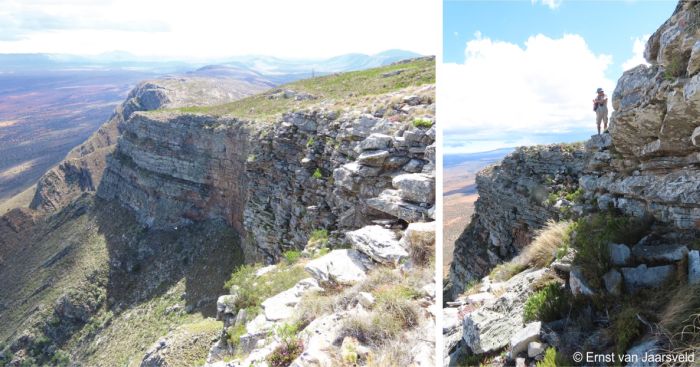
Fig. 7. The upper, shady, south-facing cliffs of the Aasvoelberg, habitat of Drosanthemum aasvoelbergense, and Nico van Wyk from Babylonstoren Farm standing on top of the cliff.
Drosanthemum (Aizoaceae), as a new genus, was named by Schwantes in 1927 and today consists of about 114 species (Liede-Schumann et al. 2020) representing many growth forms. In 2007, Hartmann divided the genus into 8 subgenera adding an additional 2 in 2014. This division, now recognising 10 subgenera, is based on molecular and plant architecture. Drosanthemum is distinguished from the related Delosperma and Lampranthus by its distinct shiny epidermal bladder cells (moisture filled papillae). Also the funnel-to-bell-shaped, usually 5-locular, hygrochastic fruiting capsules with broad, see-through valve wings, most of which are longer than the valves (Hartmann 2000). Hartmann and Bruckmann (2000) also noted an inner corky layer to the lower portion of the flower stalks in Drosanthemum, during its flowering period. Most species of Drosanthemum are shorter lived, rapid growing with a life span between 2-6 years and very floriferous plants. The covering membranes (loculi roofs) of the fruiting capsules in most species are well developed but may be absent or weakly developed in a few species, as well as in D. aasvoelbergense (Hartmann 2000). Drosanthemum is confined mainly to the winter rainfall region of South Africa (Hartmann 2007).
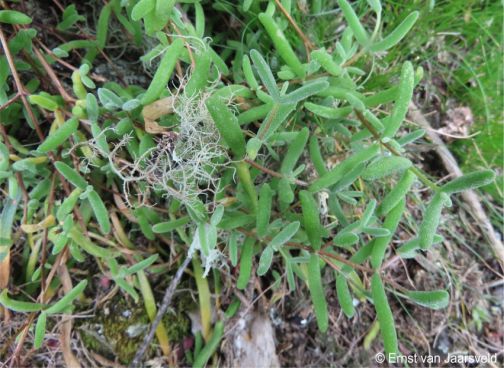
Fig. 8. Close-up of the leaves of Drosanthemum aasvoelbergense actively growing after a moist season.
Ecology
Ecology
Drosanthemum aasvoelbergense is a long-lived mesemb, starting off as a rock-squatting succulent shrublet, but ultimately becoming a cliff hanger. Plants root in crevices and on lichen covered ledges, at an elevation of 1 200-1 400 m. This open cliff face habitat is protected from fires and larger herbivores. However at the cliff top, it sometimes grows intertwined with species of grass and other Fynbos vegetation and where fires can reach. Due to the alpine conditions, and moist cloud cover at times, lichens are especially common in its cliff face habitat, including a fruticose lichen (Usnea sp.) drooping from the rock-face. Others include some crustose, foliose and squamulose lichens. Aasvoelberg is often covered in clouds due to cyclonic cold fronts in winter or convectional rains in summer. The plants grow in crevices and shallow soil with little competition from other plants and the succulent nature of the leaves enables the plant to survive dry periods. In habitat it was noticed that some plants in reach of herbivores such as the dassie or rock-rabbit (Procavia capensis), are grazed. The young leaves and stems are very fragile reflecting their disturbance-free (from larger heribores) sheer habitat.
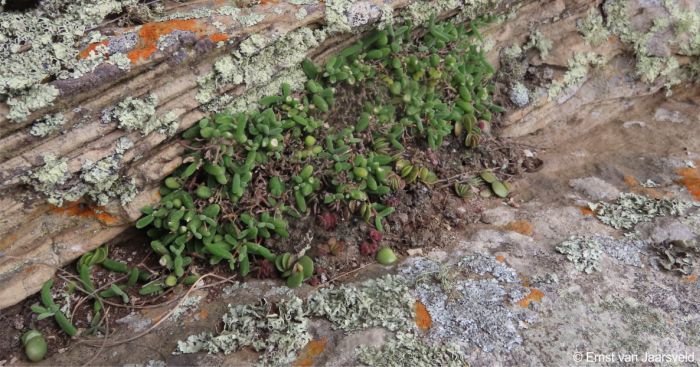
Fig. 9. When seed germinates on accessible ledges plants get grazed, by animals such as the rock rabbit (Procavia capensis). Here Drosanthemum aasvoelbergense is growing with Adromischus subdistichus and Crassula socialis.
In habitat the light pink flowers only open at midday and are pollinated by bees and small beetles. The fruiting capsules are hygrochastical, the expanding keels push open the cell lids and the exposed seeds are washed out by falling rain drops. The weakly developed covering membranes of the capsules of D. aasvoelbergense ensures the seeds are splashed out when the capsules are open. The seeds germinate in crevices and on ledges. Unlike many species of Drosanthemum in which the old capsules persist on the plant for some time, the capsules of D. aasvoelbergense remain on the plant for only a short while.

Fig. 10. A young flowering specimen of Drosanthemum aasvoelbergense close to the top on the upper south cliff of Aasvoelberg , plants are at first cliff-squatters, becoming drooping with age and ultimately a cliff-hanger. Note the insects visiting the flowers.
Annual stem growth rings counted of an old senescent specimen of Drosanthemum aasvoelbergense representing at least 25 years (plant about 1 m long). Plants grown at Babylonstoren and Kirstenbosch National Botanical Garden confirm this long-lived characteristic. This long-lived nature is also similar to other obligatory cliff-dwelling species of Drosathemum and Delosperma, such as Delosperma badspoortense (Van Jaarsv.) Klak , Drosanthemum decumbens (L.Bolus) Van Jaarsv., D. inornatum (L.Bolus) L.Bolus and D. anemophilum Van Jaarsv. & S.A.Hammer. However, here the resemblance ends. Of these 5 species only Drosanthemum aasvoelbergense, D. inornatum and D. decumbens become pendent on cliffs. Drosanthemum anemophilum is a sparingly branched erect shrub more than a metre high with unique woody capsules (Van Jaarsveld & Hammer 2004), and Delosperma badspoortensis and Drosanthemum decumbens have a persistent re-sprouting woody base (Van Jaarsveld 2018).
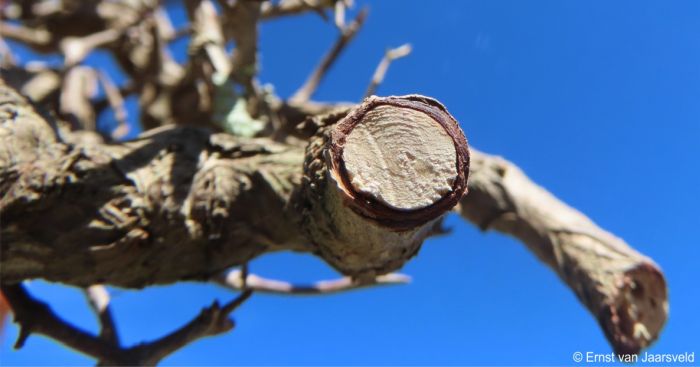
Fig. 11. Cross-section of a branch of an older stem of Drosanthemum aasvoelbergense taken from its habitat revealed at least 25 annual rings.
Uses
Use
The main use of Drosanthemum aasvoelbergense is ornamental. No medicinal or cultural uses are known.
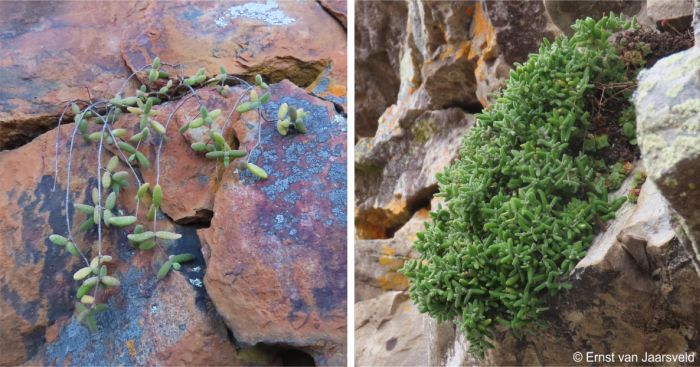
Fig. 12. Close-up of a young plant becoming drooping from a crevice on a more exposed upper rock face (left) and a well-established plant growing on the upper cliff face, with Crassula socialis.
Growing Drosanthemum aasvoelbergense
Grow
Easily grown but requires a cold climate to flower. South-African alpine mesembs, especially from the Drakensberg, have proved to be extremely successful in colder dry parts of the world, especially Denver, Colorado, USA. Panayoti Kelaidis, Curator of the Denver Botanic Gardens, who regularly visits South Africa, especially the higher lying colder parts, has successfully pioneered the growing and and development of many cold hardy South African plants. A few alpine species of Delosperma have become very popular waterwise ground covers in the Northern Hemisphere. The yellow flowering Delosperma nubigenum from Lesotho and orange-red flowering Delosperma dyeri from the southern Drakensberg were introduced by Panayoti to Colorado gardens and became very popular. Seed of Drosanthemum aasvoelbergense has been provided to Panayoti with the hope it would be introduced to ornamental gardening.
Drosanthemum aasvoelbergense is easily grown and cultivated and is best for dry semi-alpine or alpine Fynbos gardens (Van Jaarsveld 2010). Best used as a ground cover on steep embankments or rockeries, in full sun or partial shade. It is adapted to grow on mineral poor, acidic soil. The plant is easily grown in containers or hanging baskets but best in strong light. Snails and tiger moth caterpillars can be a problem. Plants grow well in a general succulent mixture, such as 2 parts sand, 1 part garden loam and 1 part well broken down compost. It is adaptable to other soils but good drainage is essential. Sow seed in the same mixture as above and cover with a thin layer of sand. Keep moist. Sow during spring or summer. Cuttings of about 5–12 cm length can be planted in sand or a mixture of sand and peat; remove the lower leaves and plant the stems to a depth of about 1-4 cm. Keep moist until well rooted. Plant into individual containers.
References
- Clarke, H. & Charters, M. 2016. The illustrated dictionary of southern African plant names. Flora & Fauna Publications Trust, Jacana, Johannesburg.
- Hartmann, H.E.K. & Bruckmann, C. 2000. The capsules of Drosanthemum Schwantes (Ruschioideae, Aizoaceae). Bradleya 18: 75–112.
- Hartmann, H.E.K. & Liede-Schumann, S. 2014. Two new subgenera and one new species in the genus Drosanthemum. Bradleya 32: 50-63.
- Hartmann, H.E.K. 1991. Mesembryanthema. In Systematics, Biology and Evolution of Some South African taxa. Contributions from the Bolus Herbarium 13. 75-157.
- Hartmann, H.E.K. 2001. Aizoaceae A-E. In Eggli, U. & Hartmann, H.E.K. (eds.) Handbook of Succulent Plants. Springer. Heidelberg, New York, etc.
- Hartmann, H.E.K. 2007. Studies in Aizoaceae: eight new subgenera in Drosanthemum Schwantes. Bradleya 25: 145–176.
- Klak, C., Hanacek, P., Curtis-Scott, O. Le Roux, A. & Bruyns, P.V. 2020. New taxa in Drosanthemum and a new genus in Drosanthemeae (Ruschioideae, Aizoaceae). Phytotaxa 459(2):139–154. https://doi.org/10.11646/phytotaxa.459.2.5.
- Lavis, M. 1969. Notes on the genus Delosperma (Mesembrieae). Journal of South African Botany 35: 145–147.
- Liede-Schumann, S., Grimm, G.W., Nurk, N.M. Potts, A.J., Meve, U. & Hartmann, H.E.K. 2020. Phylogenetic relationships in the southern African genus Drosanthemum (Ruschioideae, Aizoaceae). Peer Journals, Biodiversity and Conservation 8:e8999.
- Mucina, L. & Rutherford, M.C. (eds) 2006. The vegetation of South Africa, Lesotho and Swaziland. Strelitzia 19. South African National Biodiversity Institute, Pretoria.
- Schwantes, G. 1927. Drosanthemum Schwantes gen. nov. Zeitschritft für Sukkulentenkunde 3: 29.
- Tham, A.G. & Johnson, M.R. 2006. The Cape Supergroup. In: M.R. Johnson, C.R. Anhaeusser, C.R. & R.J. Thomas (eds.), The geology of South Africa. Geological Society of South Africa, Johannesburg/Council for Geoscience, Pretoria, 443–460.
- Van Jaarsveld, E.J. & Hammer, S. 2004. An unusual new species of Drosanthemum from Rooinek Pass in South Africa’s Western Cape. Cactus & Succulent Journal 76(3): 202–204.
- Van Jaarsveld, E.J. 2010. Waterwise gardening in South Africa and Namibia. Struik, Cape Town.
- Van Jaarsveld, E.J. 2011. Cremnophilous succulents of southern Africa: diversity, structure and adaptations. Unpublished Ph.D.Thesis, University of Pretoria.
- Van Jaarsveld, E.J. 2015. Drosanthemum badspoortensis, a new cliff-dwelling species from Badspoort, Western-Cape, South Africa. Bradleya 33/2015: 128-135.
- Van Jaarsveld, E.J. 2018. Drosanthemum decumbens (Aizoaceae), a new status for an obligatory cremnophyte from the Western Cape, South Africa. Haseltonia 24: 2–6.
- Van Jaarsveld, E.J. 2023. Drosanthemum aasvoelbergense: A new obligatory cremnophyte from the Eastern Cape, South Africa. Haseltonia 30(1):14–21.
Credits
Ernst van Jaarsveld
Kirstenbosch National Botanical Garden (Retired)
Babylonstoren Farm (Current)
Extraordinary senior lecturer and researcher,
Department of Biodiversity and Conservation, University of the Western Cape
March 2024
Acknowledgements: the author thanks Marieta Visagie for preparing the illustration.
Plant Attributes:
Plant Type: Succulent
SA Distribution: Eastern Cape
Soil type: Sandy
Flowering season: Early Summer, Sporadic/All year
PH: Acid
Flower colour: White, Pink
Aspect: Shade, Morning Sun (Semi Shade), Afternoon Sun (Semi Shade)
Gardening skill: Average
Special Features:
Horticultural zones







Rate this article
Article well written and informative
Rate this plant
Is this an interesting plant?
Login to add your Comment
Back to topNot registered yet? Click here to register.